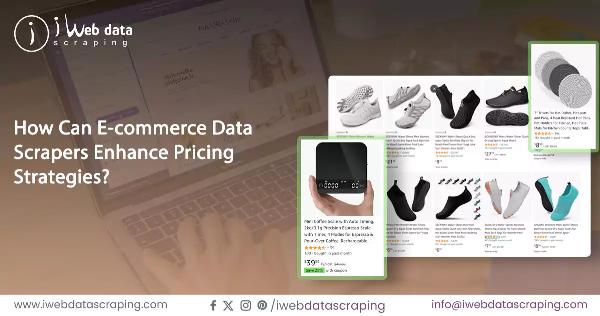How Can E-commerce Data Scrapers Enhance Pricing Strategies?

Strong 8k brings an ultra-HD IPTV experience to your living room and your pocket.
How-Can-E-commerce-Data-Scrapers-Enhance-Pricing-Strategies
In the fast-paced world of e-commerce, data scraping has become essential for businesses aiming to stay competitive and meet customer demands. E-commerce data scrapers allow businesses to collect large volumes of data from various online sources, providing valuable insights that can drive strategic decision-making.
For example, a popular online retailer can use e-commerce data scraping services to gain insights into competitor pricing strategies, product assortments, and promotional activities. By monitoring competitor websites, the retailer can quickly adjust its pricing or promotions to match or beat competitors, especially during flash sales or promotions.
E-commerce data scraping is also invaluable for understanding market trends and consumer behavior. Real-time data on product availability and stock levels can help businesses optimize inventory management, reducing the risk of stockouts or overstock situations. Additionally, extracting customer reviews and feedback from platforms like Amazon or Yelp enables businesses to gauge consumer sentiments and preferences, leading to product improvements and enhanced customer satisfaction.
Extracting e-commerce data can provide businesses with the actionable insights needed to stay ahead in today's competitive e-commerce landscape.
Benefits of Scraping E-commerce Data
Benefits-of-Scraping-E-commerce-Data
Collecting data from online sources in the competitive e-commerce landscape provides businesses with valuable insights for strategic decision-making.
Competitive Pricing Intelligence: E-commerce data scraping allows businesses to monitor competitor prices in real-time and adjust their pricing strategies to remain competitive.
Product Assortment Analysis: By scraping e-commerce websites, businesses can gather data on competitors' product assortments, helping them identify market gaps and optimize their product offerings.
Enhanced Marketing Strategies: It provides valuable insights into competitors' promotional activities, allowing businesses to fine-tune their marketing strategies for better engagement and conversion.
Improved Inventory Management: Real-time data on product availability and stock levels helps businesses optimize their inventory management, reducing the risk of stockouts or overstock situations.
Customer Sentiment Analysis: Scraping customer reviews and feedback from e-commerce platforms allows businesses to gauge consumer sentiments and preferences, helping them make informed decisions to improve products and services.
Market Trends and Consumer Behavior: It provides insights into market trends and consumer behavior, enabling businesses to adapt their real-time strategies to meet changing market demands.
Implementing data collection in e-commerce offers numerous benefits that can significantly enhance business performance. One key advantage is the ability to develop dynamic pricing strategies. By gathering real-time data on competitor pricing and market demand, businesses can adjust their prices dynamically to remain competitive and maximize profits.
For example, a fashion retailer could use the process to track trending styles on social media platforms like Pinterest. By quickly introducing similar styles into their product lineup, they can stay ahead of the trend curve and attract fashion-forward customers.
Efficient inventory management is another benefit of data extraction. Accurate demand forecasting and stock optimization reduce the risks of overstock and stockouts, ensuring that popular products are always available. A grocery delivery service, for instance, can monitor purchase trends and stock levels in real time, ensuring they have enough stock of high-demand items like fresh produce or household essentials. Real-time monitoring of inventory levels helps maintain a balanced and efficient supply chain.
It is an invaluable tool for e-commerce businesses looking to optimize their operations, stay competitive, and deliver exceptional customer value. By leveraging the process, businesses can unlock new opportunities for growth and success in the ever-evolving e-commerce landscape.
Enhancing E-commerce Strategies with Data Scraping
Enhancing-E-commerce-Strategies-with-Data-Scraping
Real-time Price Monitoring
In the dynamic e-commerce landscape, pricing is a critical factor influencing consumer behavior. The process enables businesses to monitor competitor prices in real-time, ensuring they remain competitive. For instance, during peak shopping seasons, such as holidays, a retailer can swiftly adjust prices based on competitor moves, avoiding potential sales losses.
Dynamic Pricing Strategies
It empowers businesses to implement dynamic pricing strategies. By analyzing real-time data on supply, demand, and competitor pricing, e-commerce companies can adjust prices dynamically. This flexibility allows them to optimize profits and remain competitive in a fast-paced market environment.
Competitive Price Analysis
Understanding competitors' pricing strategies is critical to success in e-commerce. It enables businesses to conduct detailed competitive price analyses. For example, an online bookstore can use data collection to monitor competitors' pricing strategies for bestsellers, promotional offers, and pricing changes. This information helps them make informed decisions to stay competitive.
Personalized Pricing and Customer Engagement
Personalized pricing strategies can significantly enhance customer engagement and loyalty. Gathering customer data for personalized pricing plays a crucial role. For instance, an e-commerce platform can use the process to analyze customer behavior and offer personalized discounts or promotions. This approach not only increases sales but also fosters long-term customer relationships.
Leveraging Data Collection for Enhanced Product Assortment
Leveraging-Data-Collection-for-Enhanced-Product-Assortment
Identifying High-Demand Products and Emerging Trends
It offers valuable insights into high-demand products and emerging trends by analyzing diverse online sources. For instance, scraping social media platforms helps retailers identify viral trends and popular items gaining consumer traction.
Implementation Scenario: Imagine discovering a trending style of sneakers on Instagram. Acting on this data allows quick stocking of these in-demand products, ensuring the capture of trend-conscious customers' interest.
Analyzing Competitor Product Offerings for Assortment Gaps
Understanding competitors' offerings is critical for creating a unique and appealing product assortment. It facilitates monitoring competitor websites and analyzing their product offerings to identify assortment gaps that can be exploited.
Implementation Scenario: For example, if a competitor does not offer eco-friendly home goods, a category witnessing rising demand, adding sustainable home products can attract environmentally conscious customers. This strategic move differentiates the brand and positions it as a leader in meeting unmet market needs.
It enhances product assortment strategies by providing insights into high-demand products, emerging trends, and competitor offerings, enabling businesses to stay competitive and meet consumer needs effectively.
Utilizing Data Extraction for Consumer Sentiment Analysis
Utilizing-Data-Extraction-for-Consumer-Sentiment-Analysis
Extracting and Analyzing Customer Reviews
Customer reviews and feedback are invaluable sources of information for improving products and services. Data scraping enables businesses to extract and analyze reviews from platforms like Amazon, Walmart, and Google shopping. For example, an online electronics store can collect reviews for headphones, identifying common themes such as praise for sound quality but criticism for comfort. This data can guide improvements, like working with manufacturers to enhance comfort and highlight features for marketing campaigns.
Leveraging Social Media Insights for Sentiment Analysis
Social media platforms provide rich sources of consumer opinion. Data collection from platforms like Twitter allows for sentiment analysis, helping gauge public perception of a brand and its products. For instance, extracting tweets and posts mentioning a brand can categorize sentiments as positive, negative, or neutral.
Understanding Consumer Sentiment for Informed Decision-Making
By understanding consumer sentiment, businesses can make informed decisions that enhance product offerings, improve customer satisfaction, and drive sales. This comprehensive approach ensures that businesses remain agile, competitive, and customer-focused, ultimately driving growth and success.
In the competitive e-commerce landscape, leveraging data scraping for consumer sentiment analysis is crucial for staying competitive and meeting customer expectations.
Conclusion
Discover unparalleled web scraping service or mobile app data scraping offered by iWeb Data Scraping. Our expert team specializes in diverse data sets, including retail store locations data scraping and more. Reach out to us today to explore how we can tailor our services to meet your project requirements, ensuring optimal efficiency and reliability for your data needs.
know more>>https://www.iwebdatascraping.com/e-commerce-data-scrapers-enhance-pricing-strategies.php
tag: #ECommerceDataScrapers,
#ECommerceDataScrapingServices,
#ExtractEcommerceData,
#WalmartDataScraping,
#AmazonDataScraping,
#ExtractGoogleShoppingData,
#ScrapeEcommerceData,
Note: IndiBlogHub features both user-submitted and editorial content. We do not verify third-party contributions. Read our Disclaimer and Privacy Policyfor details.


